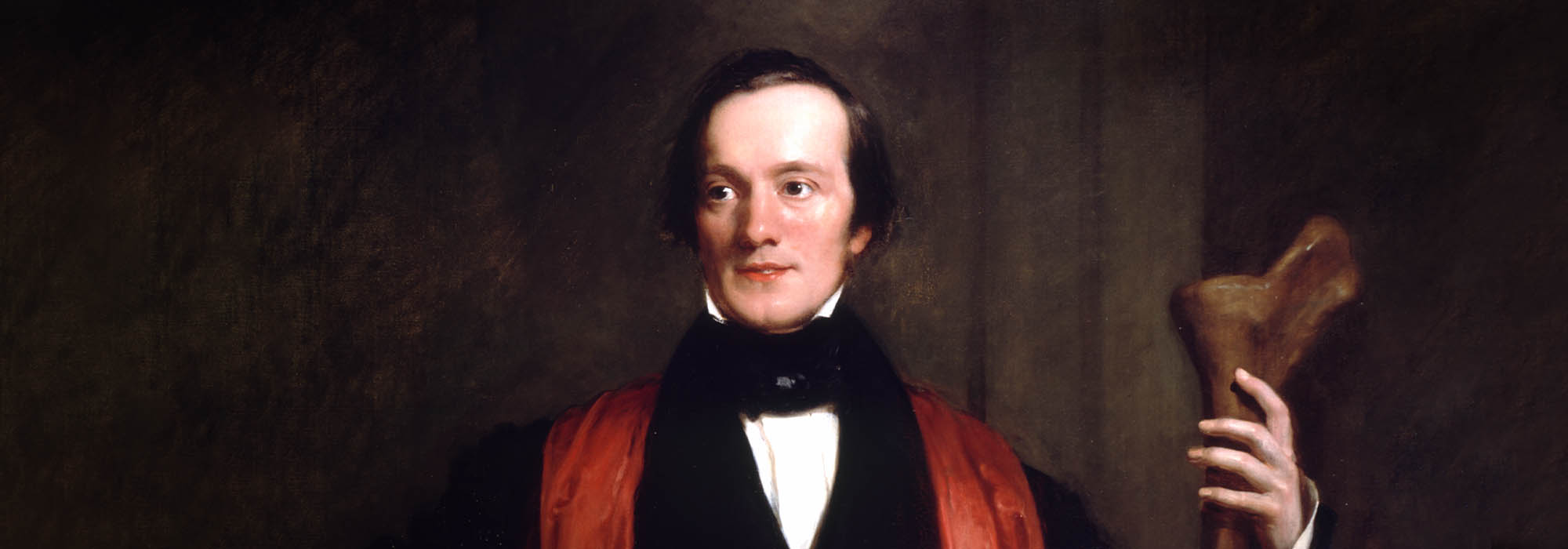
The highlight of any trip to the Natural History Museum is the dinosaur collection. Woven into the reconstructions of these awe-inspiring creatures is the story of one of Britain’s greatest scientific triumphs, now proudly celebrated on a new series of coins.
Dinosaur Hunter
Its origins lie with Dr Gideon Mantell. An amateur palaeontologist, Mantell was the original dinosaur hunter. The Iguanodon tooth he found with his wife was the first dinosaur fossil ever to be formally identified and named in 1825. Later, in 1832, he was able to use his knowledge of anatomy to piece together the remains of Hylaeosaurus, the first armoured dinosaur ever discovered.
Mantell continued to unearth fossils from the chalklands of Sussex, but by 1838 he had fallen on hard times, forcing him to sell part of his collection to the British Museum; in 1853 it acquired the rest. But, while his fossils form the basis of the Natural History Museum’s dinosaur collection, it was another great mind who made the link that forms the basis of our modern understanding of the creatures we now know as dinosaurs.
A Controversial Figure
With Mantell’s fossils now in possession of the British Museum, his great rival Richard Owen was able to study them. Born in Lancaster in 1804, Owen was one of the most controversial figures in Victorian science. A contemporary of Charles Darwin, he disagreed with Darwin’s theory of evolution. Whilst history shows us he was on the wrong side of that debate, he was an undeniably brilliant natural scientist, chosen to tutor royalty. But, he was also famously difficult to work with. Mantell described Owen as ‘overpaid, over-praised and cursed with a jealous monopolising spirit’.
Making the Link
One of the leading anatomists of the day, Owen was the first to realise that the fossilised remains of Iguanodon and Hylaeosaurus shared similar characteristics with Megalosaurus, a creature described by William Buckland in 1824. He observed that the vertebrae at the base of the spine of all three animals had become fused during their lifetimes.
Owen coined the term ‘Dinosauria’ to describe this new group of animals in a paper published in 1842. Dinosauria is commonly quoted as meaning ‘terrible lizard’, but in his report Owen actually refers to dinosaurs as ‘fearfully great’, an acknowledgement of their large size which dwarfed any living reptile.
Dinomania
The name became established with the scientific community and soon after entered the public imagination. People were gripped by ‘dinomania’ and crowds flocked to see the first full-sized, three-dimensional models of fossil remains when they went on display in 1854 – amongst them Queen Victoria and Prince Albert. The Crystal Palace sculptures were created by Benjamin Waterhouse Hawkins and overseen by Richard Owen himself.
Falling Out of Favour
New fossil discoveries were made throughout the 1800s and Victorian palaeontologists began to look at common characteristics that might link them together. Two groups emerged – the ornithischians (‘bird-hipped’) and saurischians (‘lizard-hipped’). In 1887 Harry Seeley published a paper on these two new groups and denounced ‘Dinosauria’. Owen’s taxonomic group drifted out of favour but interest was revived in the 1970s when palaeontologists unearthed new evidence that birds evolved from dinosaurs. ‘Dinosauria’ was not an obsolete group after all and dinosaurs were very much back in the scientific spotlight.
A Tireless Campaign
Not content with merely describing dinosaurs, Owen campaigned tirelessly for the founding of the Natural History Museum so everyone could appreciate these amazing creatures. Taking charge of the British Museum’s natural history collection in 1856, Owen quickly ran out of space as the collection continued to grow and was swelled by new species of exotic animals and plants arriving from across the British Empire.
He convinced the board of trustees that a separate building was needed and work began on a new building. Owen’s vision was realised when the Natural History Museum opened its doors on 18 April 1881. It remained part of the British Museum until 1963 and wasn’t officially renamed as the Natural History Museum until 1992.
Today the Natural History Museum is the most visited natural history museum in Europe, attracting around five million visitors every year. Thanks to Owen’s vision of a ‘cathedral to nature’, the Museum can display huge creatures like dinosaurs in all their majestic glory.
An organisation that has inspired so many people, instilling within them a lifelong love of the natural world, we’re proud to have worked with the Natural History Museum to bring the coins of The Dinosauria Collection to life. Often overlooked, it’s only fitting that this story of British discovery has been beautifully retold on a series of coins, restoring it to its rightful place in public consciousness.
Discover great stories from history and how we're celebrating these moments within The Royal Mint
Read more
